Revolvers require a lot of reloading. Through the course of a range session you’ll have to reload about three times as often as your Glock-toting counterparts. You could look at this as an inconvenience or a blessing in disguise. I am more inclined to the latter. Since you have to reload a lot, you’ve got a lot of chances to practice your reloading technique. Today I’m going to talk about my favorite reloading technique: the Universal Revolver Reload.
Even if you don’t believe you will need to reload in extremis, it’s not a bad idea to learn an efficient technique. If you’re an old RevolverGuy you know there are several ways to skin this cat. If you’re just becoming a RevolverGuy, you may be confused by the various ways you see people reloading (many of whom haven’t adopted any specific technique). There are several ways to reload the revolver, but this one offers some benefits that I’ll talk about at the end of this article. And if you don’t like it, stay tuned, and I’ll talk about some other techniques in the future.
Caveat: While I am working on an article for left-handed shooters, the technique presented here is for right-handed shooters. As such, I will use “right hand” and “left hand” instead of the more common, yet inconsistent, (and confusing) cool-guy nomenclatures for your two hands that abound in the shooting world.
Gear Setup
The Universal Revolver Reload will require some equipment. First, you will need a speedloader. I have reviewed a number of speedloaders on this site and my preference, in order, is as follows: S.L. Variant, Jetloader, and Safariland Comp II. This will be dictated by personal choice and what is available for your revolver.
The next thing you will need is a speedloader pouch. Though some use their pocket, this isn’t preferred (at least by me). First, because it is carried on strong side, there is a good chance your pocket will be obscured by your holster. Second, there’s a bunch of other stuff in my pocket, and probably in yours, too. This creates several nasty possibilities: the loader coming out with coins stuck in it, stuff coming out of the pocket with the loader, something activating the loader and releasing the cartridges in my pocket, or the loader repositioning itself in my pocket to a butt-down attitude. A speedloader pouch will ensure both a consistent grip on the loader, and that it is always carried in a consistent location.
Since you are reloading with your right hand, the speedloader should be carried on your right side. I prefer to carry my speedloaders just forward of the holster (for 3 o’clock, OWB carry). For outside-the-waistband carry I think Jox Loader Pouches are as good as it gets. I have also reviewed several other loader pouches here. Again, your selection will be limited by the revolver you carry and your preference in speedloaders.
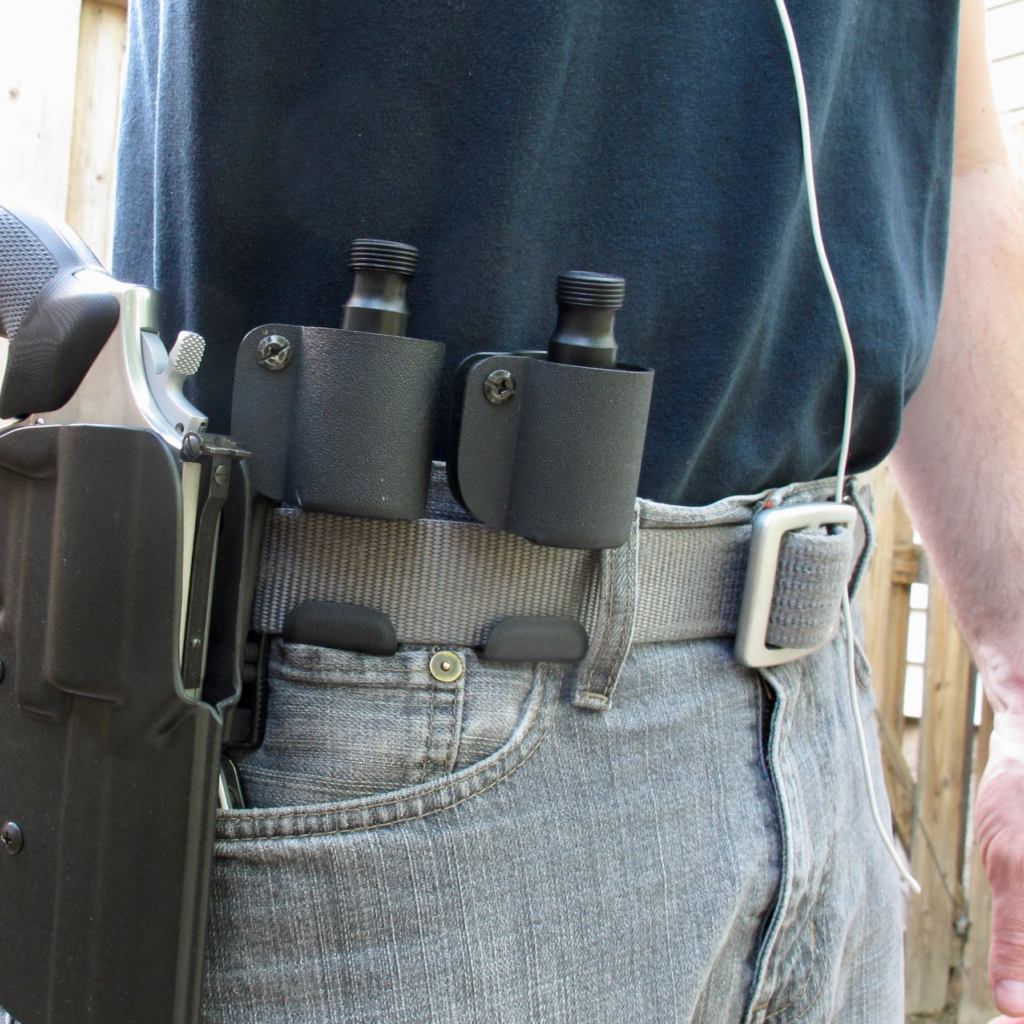
The Universal Revolver Reload
The Universal Revolver Reload was so named by Grant Cunningham. The technique works on most Colt, Ruger, and S&W revolvers. The technique for opening the cylinder release latch (which makes the URR “universal”) is discussed in Step 1 below. I personally feel this is the most useful revolver reloading technique, but your opinion may vary (and that’s OK).
Like any of these techniques, the Universal Revolver Reload is a multi-step process. With an autoloader there are basically three steps: get the empty magazine out, get a full magazine in, close slide. With a revolver there several more discrete steps that must be accomplished. This description of the Universal Revolver Reload begins with the revolver at full extension in a two-handed firing grasp, as shown below.
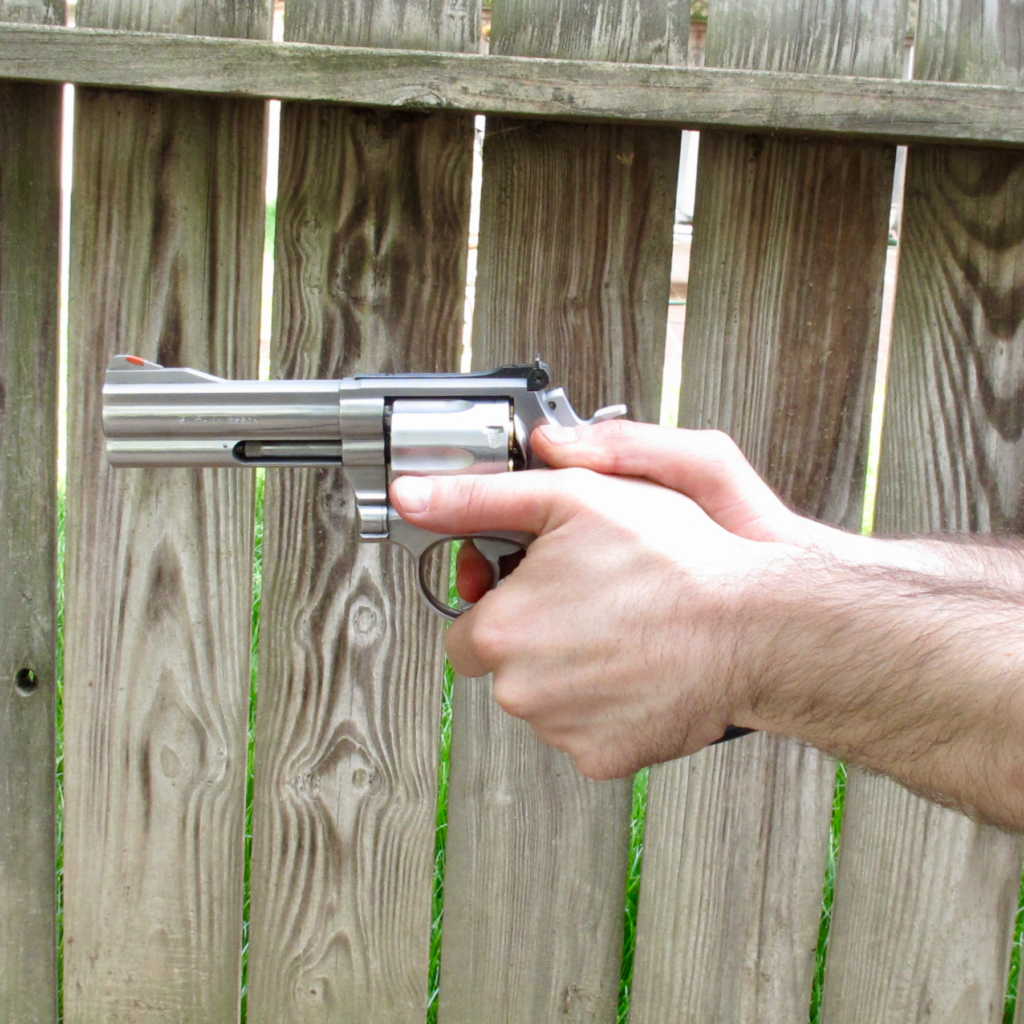
Step 1: Open and Orient the Gun
Several things have to happen at once. First, your left hand should release its firing grip and move forward on the gun. Position the hand just under the trigger guard and frame. This will accomplish two purposes: it will cradle the revolver, and it will allow the middle and ring fingers to push the cylinder out of the frame window. The thumb of the left hand should wrap over the cylinder. Supporting the cylinder will be important in the next couple of steps.
Simultaneously, your right thumb should stay put. As the revolver is pulled back into the workspace, pressure provided by your left fingers will cause it to rotate slightly. This is enough movement for your thumb to depress the cylinder release latch on a Ruger or S&W revolver. If you are shooting a Colt revolver, this will also snag the latch as the revolver rotates far enough forward to provide reverse pressure against the latch. As you activate the latch, the fingers of your left hand should begin to push the cylinder out of the frame window. As soon as you have begun to open the cylinder, release the grip with your right hand. To make this all even more complicated, as all of this is happening the gun should be brought back into your workspace and be oriented more or less vertically.
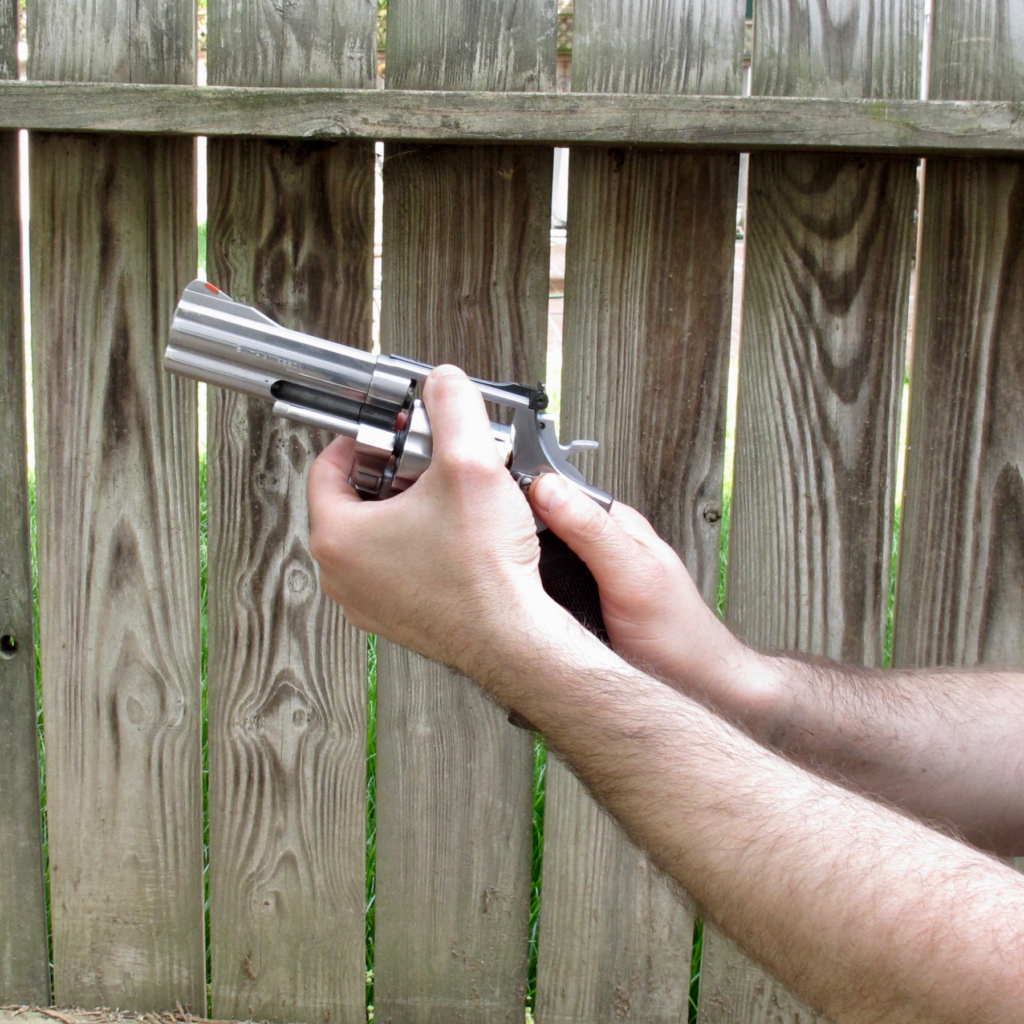
Step 2: Eject Spent Brass
Getting the brass out of the cylinder is the next step. To accomplish this, ensure the gun is rotated to a muzzle-up attitude. With the right hand, slap the ejector rod firmly. Even on full-sized revolvers, the ejector rod will not throw to a distance exceeding the length of the brass, so you want to create some energy. The brass should be ejected with authority. If you have a smaller revolver with a very short ejector rod you may wish to slap it harder. First, the shorter rod means it is more rigid and less likely to be bent. This also creates more energy, which helps to deal with the shorter throw of the rod.
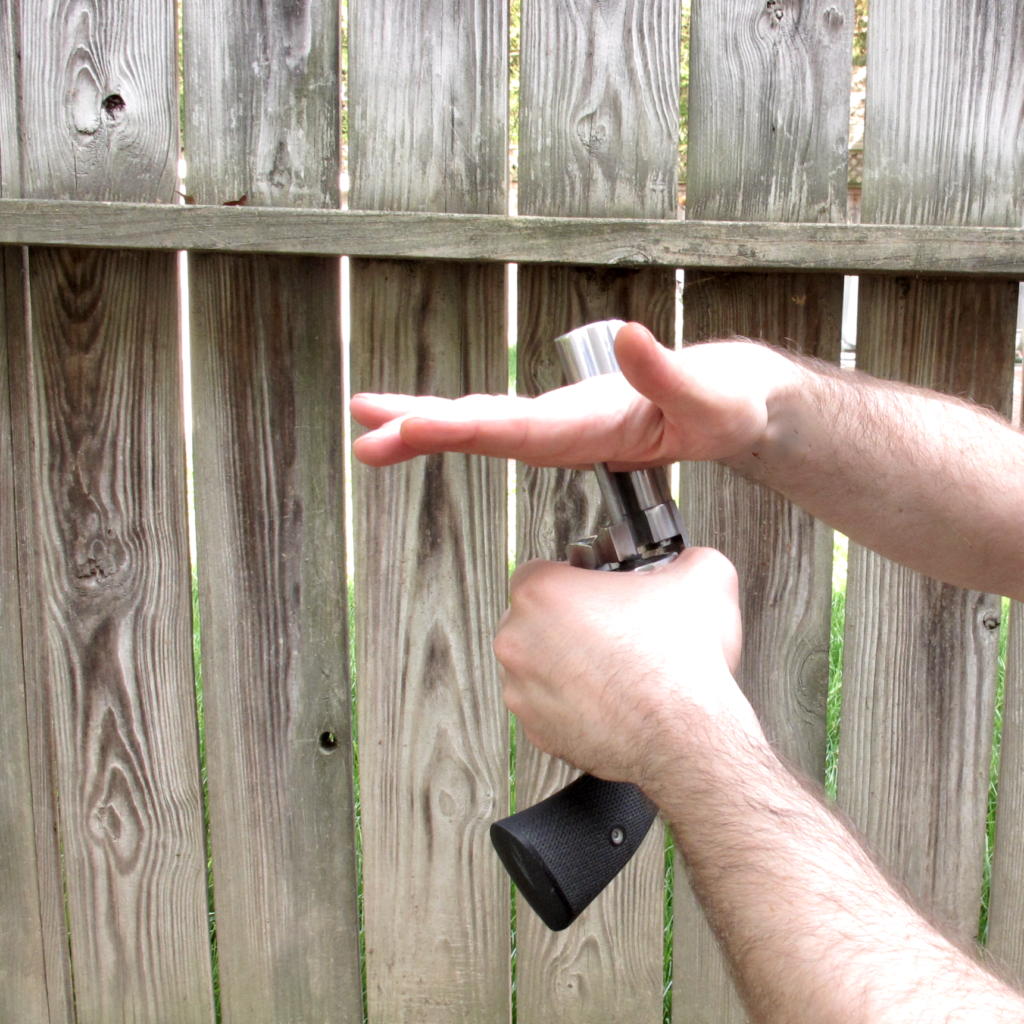
Step 3: Re-Orient the Gun and Retrieve Ammunition
As soon as you have slapped the ejector rod, your right hand should drop to your speedloader pouch and retrieve the speedloader. The left hand should rotate the revolver to a muzzle-down attitude. The severity of this orientation will depend on the speedloader you are using. If you are using one that relies solely on gravity to seat the rounds, the gun will have to be very nearly vertical. This is one of the major benefits of the S. L. Variant and Jetloader speedloaders. Because they are spring-loaded and propel the cartridges into the chambers, the gun can be oriented much closer to horizontal as shown below. This also helps in keeping the gun near eye-level. It still must have a slight downward cant to ensure the cartridges remain seated.
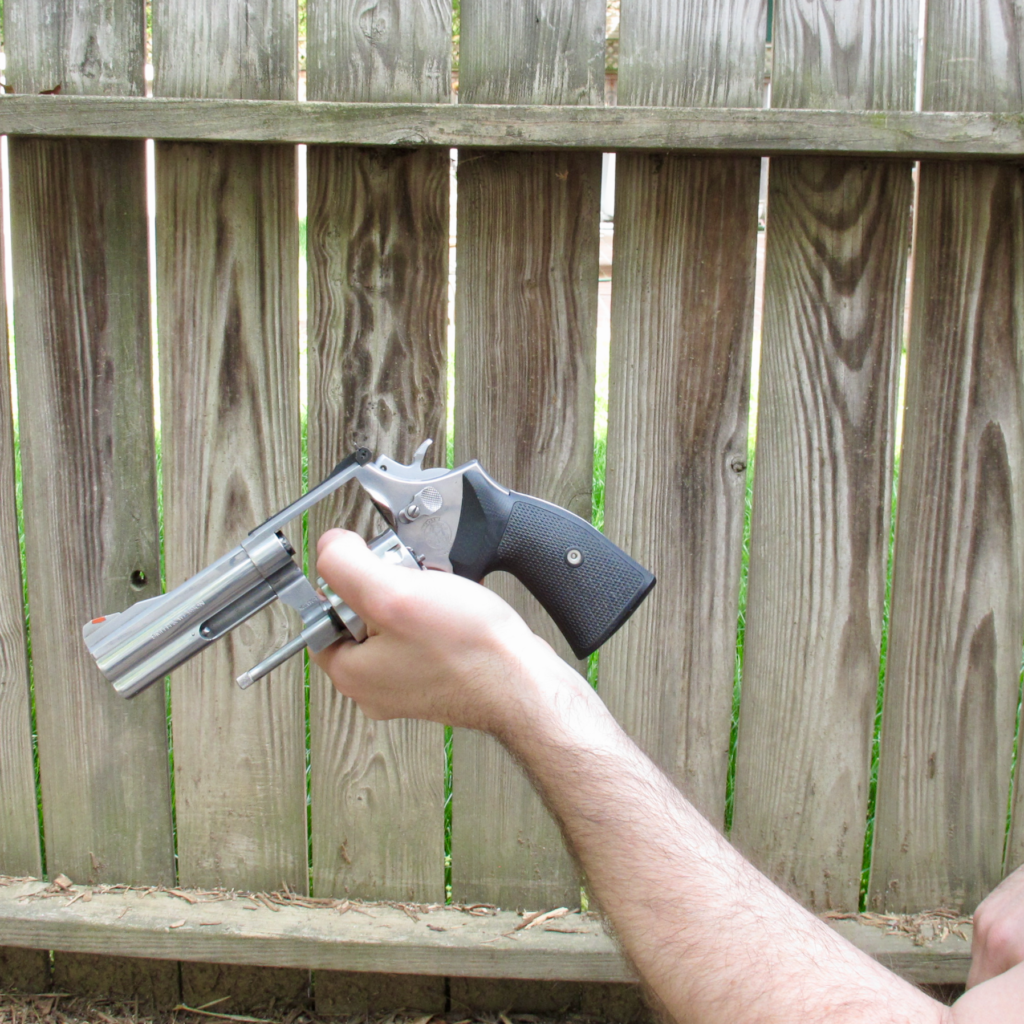
Step 4: Align and Release Cartridges
With the cylinder voided of brass the the gun correctly oriented, you are ready to insert fresh ammunition. Bring the speedloader to the gun. The most delicate part of the Universal Revolver Reload is aligning each cartridge with a charge-hole. At this point you should SLOW DOWN. The rest of the movements you have accomplished to this point can happen extremely quickly but this step will require some finesse. This is similar to the act of putting a magazine in a semi-auto, only six times harder.
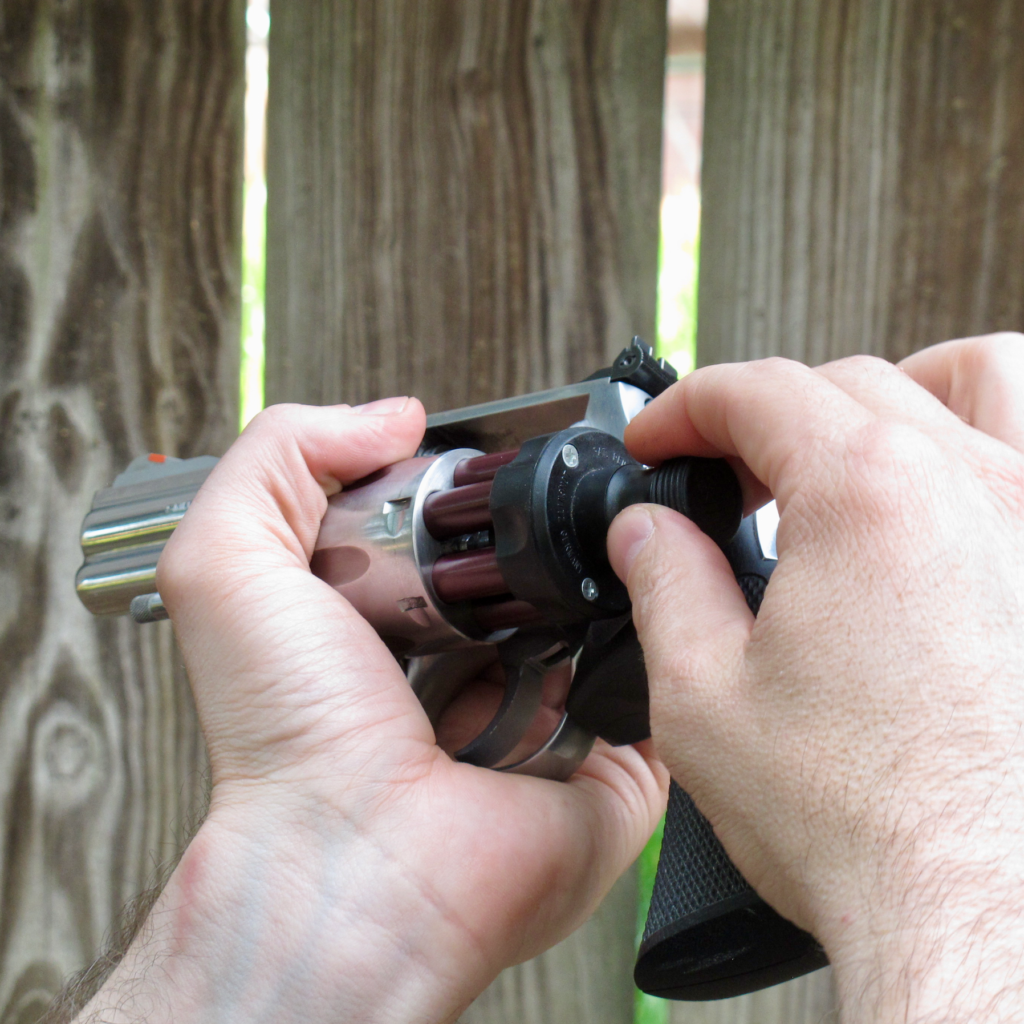
To ensure correct alignment, I visually select two of the chambers on the outboard side of the cylinder. As I move the speedloader to the cylinder, I choose two outboard cartridges and align them with the appropriate chambers. I then “look” the two cartridges into the two chambers. Aligning only one cartridge/chamber combo will not ensure the entire loader is correctly aligned, but two will.
Once the cartridges are correctly aligned, seat the loader fully. Activate the loader to release the cartridges. Depending on the design of the loader this will require that you press firmly down on the loader body (S.L., Jet, Comp I, II, III) or twist a knob (HKS, 5-Star).
At this point the empty speedloader is useless, so you should get rid of it. Simply releasing the loader will usually allow it to simply fall away. I don’t recommend an additional motion to throw it away. Occasionally, and depending on your grip, this may mean that the loader gets caught in the semi-open palm of the left hand as shown below. If this is the case, a quick downward sweep with the right hand will clear it.

Step 5: Close the Gun and Reacquire a Firing Grasp
As soon as the cartridges are seated and the speedloader is out of the way, close the cylinder. All this takes is a quick rotation of the left-hand palm. At the same time, the right hand should move back to the grip. The right hand should re-assume control of the revolver, and establish a firing grasp.
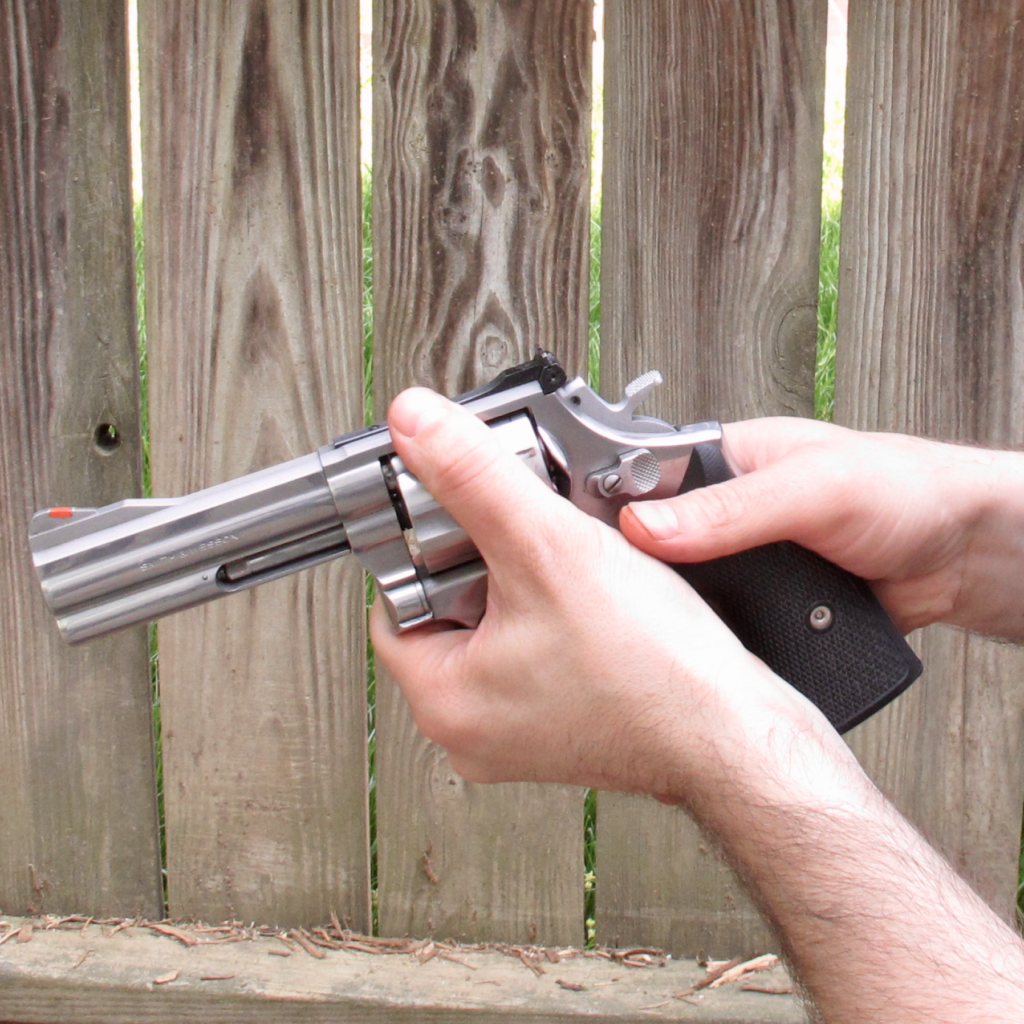
The left hand can pull back to its normal firing grasp position, as well. Achieve a solid firing grasp and present the gun back out to the target if necessary. You have now completed the Universal Revolver Reload.
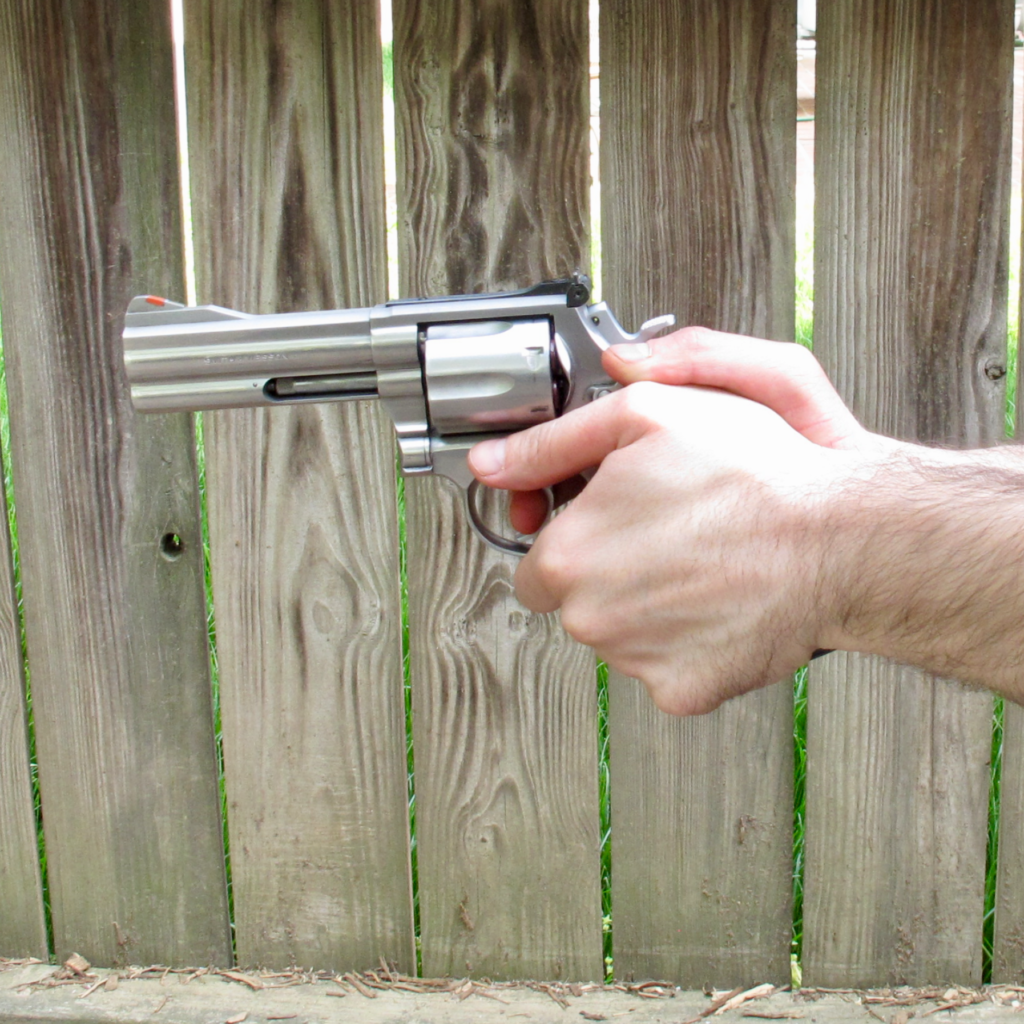
Pluses and Minuses
The biggest controversy around this technique is the swapping of the gun from hand to hand. Let’s talk about the pluses and minuses of the Universal Revolver Reload.
Swapping Hands: My biggest problem (and everybody else’s) with this technique is that the guns switches from right hand to left hand and back to right hand before it is complete. This is a complicated dance, and Mike wrote about it entertainingly and at length recently. There is all sorts of potential for things to go wrong, not the least of which is dropping the gun. That is an immediate disqualifier in competition, and obviously undesirable in a self-defense situation. It also takes time to do all this switching and swapping. But it does offer a benefit…
Right-Handed Reloads: the reason for all the hand-swapping is so your right hand can do the work of lining up six (or five, or seven, or eight) cartridges with an equivalent number of charge holes. At the same time. This is also a complicated dance. It can be done with the left hand and Nate Parker at Priority Performance is very good at it; you can watch him do it HERE. The old dog that is your left hand can be taught new tricks. For my money, though, I like the confidence that comes from reloading with my right hand.
Universality: The Universal Revolver Reload is more or less universal. This technique should work on all Ruger, and S&W designs, as well as their derivatives. If you carry different revolvers, or just shoot a bunch of them, this means you have a technique that will work for all of them.
The bottom Line
You may decide that this is not the technique for you. If not, that’s cool. Stick with us and we will cover a couple more techniques in the coming weeks. Again, even if you don’t expect to need to reload, take the time to learn a technique. If nothing else it will make your time at the range more efficient!

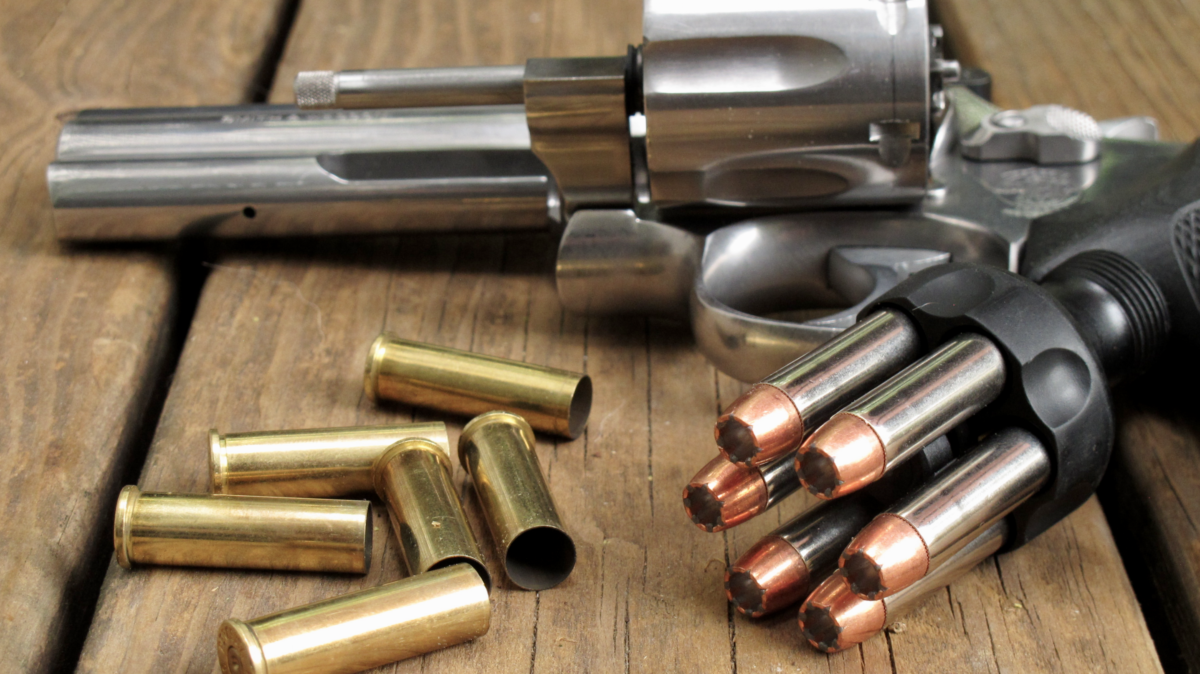
I’ve done a lot of reloads.
And one thing needs to be covered: The hot gun
Doing more than one or maybe two reloads in
succession really brings the temperature of the
gun, especially stainless steel, way up. This is
true even using .38s in a .357.
Any techniques to handle a “burning” cylinder
and forcing cone area?
Full disclosure, I’m a lefty who transfers to the
right hand and then reloads with the left.
One other thing I’ve found is that having a mix
of speed loaders is a no-no. Funny how you
can forget whether to push (Safariland) or
twist (HKS).
Ed,
I haven’t had the same issues you mention. I have found that I can get through an IDPA stage without the gun heating up too much for me to handle it. That’s six in the gun and up to four reloads, for a maximum of 30 rounds. It is possible that the big cylinder and heavy underlug of the 686 take longer to heat up. What gun are you shooting? In a few weeks up I’ll have a review online for you guys about a gun that packs a little more punch than the ol’ .357; that one might get hotter, quicker, too.
I absolutely agree with you about standardizing speedloaders! I don’t have any twistie loaders in my rotation for that very reason. I’m just too used to pressing the loader in.
Thanks!
Justin
Ed, that was one of Mas Ayoob’s objectives in developing the Stressfire Reload for revolvers. I’ll get to work on an article to explain it. The technique keeps fingers away from the hot forcing cone.
Yes, Ayoob’s Stressfire technique is what I use. It eliminates the finger-against-the-hot-forcing-cone problem. Also the cylinder is cupped in the left hand with the hand parallel to the ground, instead of the left hand being outwards. It is a little slower than the other techniques like the FBI reload, but fewer failure points.
Paul
Paul, you’re reading my mind. I’ve got a StressFire reload article ready to publish. It should be in the queue soon!
Sounds good, looking forward to it!
Paul
UncleEd, how are you holding the cylinder when you reload (which finger(s) are through the frame window)? There are a couple options and they require slightly different techniques to keep your hand off the forcing cone. I haven’t ever had a cylinder too hot to handle, but the forcing cone can get uncomfortable.
I agree on the speed loaders. I have one HKS that I unload my defensive ammo into at the range (I dremeled a small divot in the center post so that it lines up with the center on the cylinder easily, and I let the rounds drop out of the cylinder into the loader holes). I do all of my practice with my Safariland loaders, and I have caught myself trying to push the HKS to release when loading back up after I’m done at the range.
That’s the way I was trained, it works well enough that I’m faster with a K frame and comp 2s than with a box loader. Not that that’s very fast. What I would like to add is that I like to hold the loader by the body, not the end as in your photo, which allows me to line up cylinder to loader- the gross shape, not the flutes, then I kind of twist the loader around until the rounds catch the holes. Most of the time I don’t even have to look down to do this. The other thing regards dropping the loader: if you let go of it and close the cylinder, it should “wipe” clear without too much fuss.
The blessing in disguise is aptly stated. You develop muscle memory reloading the same revolver ad infinitum. Yes, the cylinder can get hot, especially in a weekend training class, but overall, there is a bit more wiggle room in getting the speed loader lined up.
Autoloaders, while faster to get back into action, have that down time where you scrape your thumb stuffing rounds back into the magazine. Try reloading a few hundred rounds over a training weekend and see how your thumb is – unless you cheat with one of these mag loader gadgets, and even then, it can slow you down. Then there is the speed reload where you have to get the magazine lined up exactly or it won’t go in. I’ve seen that happen with single and double stack magazines a LOT, and have done it myself – they don’t go in at the ‘wrong angle of attack’.
In the dark, when it’s cold and raining, yes, I’ll gladly opt for a metal ‘box’ with ammo pre-loaded, but at the same time, I’ve manipulated speed loaders in the same circumstances.
Last I checked, Jerry Miculek could reload a revolver faster than Robby Leatham could with a bottom feeder. : )
Justin,
This is the exact reload I do with one small difference. Instead of grabbing the speedloader handle I grab the outside surface of the body of the speedloader. I feel it gives me a little more control while lining the rounds up to the charge holes. I picked this tip up from Massad Ayoob. I believe it was in his book Stressfire.
Martin,
I’m with you on some speedloaders, especially the Comp Is and IIs; there’s just nothing to grasp there. On my SL/Jet speedloader carriers the pouch covers the whole body, so that’s what I go with.
Thanks for writing in,
Justin
I appreciate this article. Any interest in an accompanying video?
I settled on this reload myself after swearing I’d make the weak hand reload work. My thought was, if I already got lucky on a solid grasp out of the holster, why roll the dice every six and risk spoiling a good thing?
I’ve since heard of guys busting crane screws and was unwilling to accept that possibility on my serendipitously acquired 66-3. Trying various means to support the cylinder while reloading never were satisfactory and I eventually submitted to the realization that the “URR” is probably the strongest and simplest option (after dabbling with the FBI reload – I couldn’t resist).
Justin – is that an Edge Works EDC belt in the #2 photo?
Ed – I toast my knuckles too on this reload, but have tried to get used to always grasping the cylinder closer to the charge holes so my driving finger doesn’t rest on the forcing cone. Enough repetition has meant my last few range sessions only begin serving BBQ when I’m approaching the 150 round mark. But I have skinny fingers so I may have more room to adjust than most.
Jason,
I won’t rule out a video but I’ll have to find the time and space to do it (and to be honest I’d prefer to find a model to demonstrate – I like to stay behind the camera).
The belt is a Patagonia belt I have worn for years. It’s starting to get a little worn but I like to use stuff until it falls apart.
Thanks!
Justin
That’s how I learned, but have worked hard to learn to reload with my left hand….it is faster if you practice it. And nothing rides in my pocket with a speedloader….
I noticed in the 3rd photo of this article that the thumb of the shooter’s left hand was at the BC Gap (Barrel-Cylinder Gap). That can prove rather hazardous to one’s errant digit. In the case of the revolver I carry (a Smith & Wesson 460V), it’s not only hazardous, but a rather quick means of dramatically altering, or an out-right traumatic-amputation, of the digit in question, as with the more powerful ammunition it can digest . . . well, let’s just say that the display of fire is worthy of a 4th of July evening (Note: I still have all of my digits in their original orientation). Just a comment based upon my observation.
Hi, David and welcome! I addressed this at some length a few months ago. You can find the post HERE. Thanks for writing in,
Justin